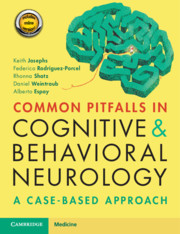Book contents
- Common Pitfalls in Cognitive and Behavioral Neurology
- Common Pitfalls in Cognitive and Behavioral Neurology
- Copyright page
- Dedication
- Contents
- Diseases Discussed in the Book
- Preface
- Acknowledgements
- Abbreviations
- Part 1 Missing the Diagnosis Altogether
- Part 2 Misidentifying the Impaired Cognitive Domain
- Part 3 Missing Important Clues in the History
- Part 4 Failure of Pattern Recognition
- Part 5 Difficult-to-Characterize Cognitive/Behavioral Disorders
- Part 6 Clinical Findings That Are Subtle
- Part 7 Misinterpreting Test Results
- Part 8 Attributing Findings to a Known or Suspected Disorder
- Case 36 “I Have Snored All My Life and It Never Affected My Work”
- Case 37 Starting Early
- Case 38 “I Have Been Taking the Same Medications for Years”
- Case 39 Cognitive Impairment and Blood Pressure Fluctuations
- Case 40 Corticobasal: The Syndrome versus the Pathology
- Part 9 Missing Radiographic Clues
- Part 10 Management Misadventures
- Index
- Plate Section (PDF Only)
- References
Case 38 - “I Have Been Taking the Same Medications for Years”
from Part 8 - Attributing Findings to a Known or Suspected Disorder
Published online by Cambridge University Press: 03 November 2020
- Common Pitfalls in Cognitive and Behavioral Neurology
- Common Pitfalls in Cognitive and Behavioral Neurology
- Copyright page
- Dedication
- Contents
- Diseases Discussed in the Book
- Preface
- Acknowledgements
- Abbreviations
- Part 1 Missing the Diagnosis Altogether
- Part 2 Misidentifying the Impaired Cognitive Domain
- Part 3 Missing Important Clues in the History
- Part 4 Failure of Pattern Recognition
- Part 5 Difficult-to-Characterize Cognitive/Behavioral Disorders
- Part 6 Clinical Findings That Are Subtle
- Part 7 Misinterpreting Test Results
- Part 8 Attributing Findings to a Known or Suspected Disorder
- Case 36 “I Have Snored All My Life and It Never Affected My Work”
- Case 37 Starting Early
- Case 38 “I Have Been Taking the Same Medications for Years”
- Case 39 Cognitive Impairment and Blood Pressure Fluctuations
- Case 40 Corticobasal: The Syndrome versus the Pathology
- Part 9 Missing Radiographic Clues
- Part 10 Management Misadventures
- Index
- Plate Section (PDF Only)
- References
Summary
This 67-year-old right-handed woman presented with a 2-year history of tremor and gait difficulties followed by cognitive impairment. The rest tremor appeared two years before her initial exam, followed six months later by falls and slow gait. Over the last year, she noticed difficulty maintaining her focus and frequently lost her train of thought. Word-finding impairment with frequent word substitutions emerged in addition to difficulties operating household appliances (e.g., remote control), which were not attributed to motor deficits. Her sister noticed she was forgetful and repetitive. She had experienced depression since age 17, currently managed with paroxetine 50 mg and amitriptyline 200 mg daily. In addition, she was on diazepam 10 mg daily for anxiety and zolpidem 10 mg at bedtime as a sleeping aid. On exam, she exhibited asymmetric resting tremor, bradykinesia, and rigidity. Her gait was slow with decreased stride length and impaired postural reflexes.
- Type
- Chapter
- Information
- Common Pitfalls in Cognitive and Behavioral NeurologyA Case-Based Approach, pp. 119 - 121Publisher: Cambridge University PressPrint publication year: 2020



